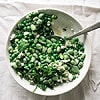 Pulses are part of an exciting food trend that’s gaining momentum worldwide, but they’re not as uncommon as you might think. You’ve likely been eating pulses for years.
Pulses are part of an exciting food trend that’s gaining momentum worldwide, but they’re not as uncommon as you might think. You’ve likely been eating pulses for years.
What Is a Pulse?
A pulse is the edible, dried seed of certain legumes, such as lentils, beans, and chickpeas.
Here are some of the more common pulses you might see while shopping at Publix:
- dry beans (black, dark red or light red kidney, black-eyed peas, great northern, navy, pinto, and lima)
- dry peas (split green, split yellow, and whole green varieties)
- chickpeas or garbanzo beans
- lentils (green and red varieties)
Pulses are an affordable, versatile food—plus, they bring countless dietary benefits.
Why Eat Pulses?
High in protein, fiber, and other nutrients, pulses offer a variety of benefits as part of a balanced diet.1
They’re heart smart. An estimated 73.5 million adults in the United States have high LDL cholesterol, which more than doubles the risk of heart disease compared to those with ideal cholesterol levels.2 Since dietary changes can affect cholesterol levels, experts recommend a balanced diet that includes high-fiber foods such as pulses. Pulses contain a special type of dietary fiber called soluble fiber, which has been shown to help lower LDL cholesterol when it’s part of an overall balanced diet that is low in saturated fat and cholesterol and rich in fruits, vegetables, and grain products.3 As it turns out, beans really can be good for the heart!
They’re veggies that keep on giving. More than 80 percent of Americans are not eating enough vegetables.4 Pulses make excellent vegetable options because they give you a big fiber bang for your buck. Many pulses contain more fiber per cup compared to many other high-fiber foods, such as fruits, whole grains, and nuts. So make sure pulses are a part of your weekly veggie intake.
How Many Pulses?
The 2015–2020 Dietary Guidelines for Americans shows that Americans are not eating enough pulses. While recommended amounts are 2–3 cups per week for men and 1.5–2 cups per week for women, most are only consuming about 0.5 cups per week.
Here are some great ways to step up your intake of pulses:
- Pick up some hummus from the Publix Deli and incorporate it into lunches, snacks, or appetizers. It’s tasty with pita bread, carrots, and various veggies.
- Shop for dry peas, dry or canned beans, lentils, and chickpeas on the grocery aisles.
- The Publix Better Choice shelf tags can help you select products that are lower in sodium, including canned beans and hummus.
Know your numbers with health screenings from the Publix Pharmacy.
Learn more about managing cholesterol levels.
Sources:
1"What Are Pulses?" Pulses.org. June 22, 2017.
2U.S. Department of Health and Human Services. "High Cholesterol Facts." Centers for Disease Control and Prevention (CDC). March 17, 2015.
3Thalheimer, Judith C., RD, LDN. "A Soluble Fiber Primer — Plus the Top Five Foods That Can Lower LDL Cholesterol." Today’s Dietitian. December 2013.
4“Shifts Needed To Align With Healthy Eating Patterns.” 2015-2020 Dietary Guidelines for Americans, 8th ed. U.S. Department of Health & Human Services. November 21, 2016.

 You are about to leave publix.com and enter the Instacart site that they operate and control. Publix’s delivery and curbside pickup item prices are higher than item prices in physical store locations. Prices are based on data collected in store and are subject to delays and errors. Fees, tips & taxes may apply. Subject to terms & availability. Publix Liquors orders cannot be combined with grocery delivery. Drink Responsibly. Be 21. For prescription delivery, log in to your pharmacy account by using the Publix Pharmacy app or visiting
You are about to leave publix.com and enter the Instacart site that they operate and control. Publix’s delivery and curbside pickup item prices are higher than item prices in physical store locations. Prices are based on data collected in store and are subject to delays and errors. Fees, tips & taxes may apply. Subject to terms & availability. Publix Liquors orders cannot be combined with grocery delivery. Drink Responsibly. Be 21. For prescription delivery, log in to your pharmacy account by using the Publix Pharmacy app or visiting 
